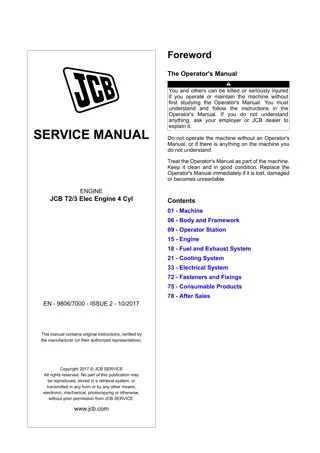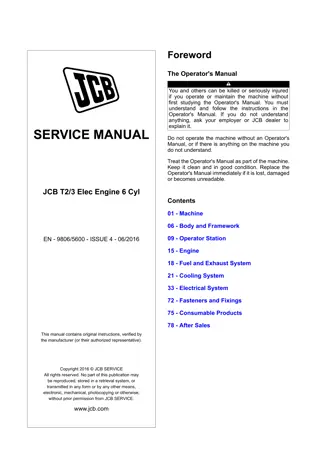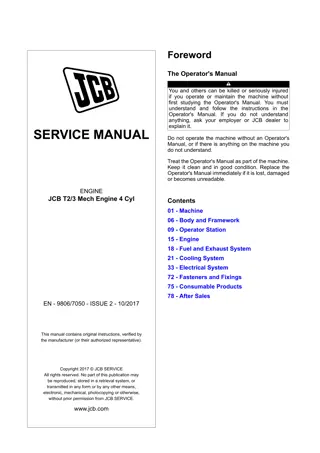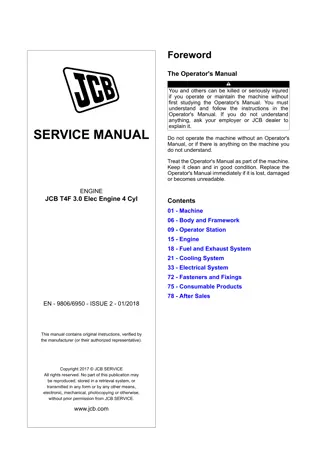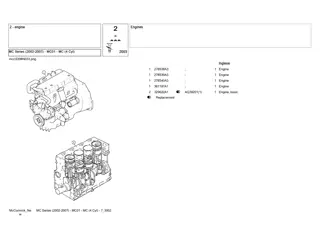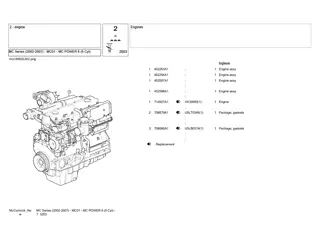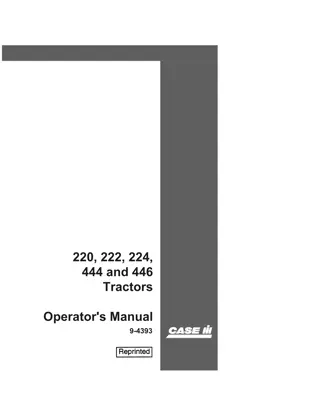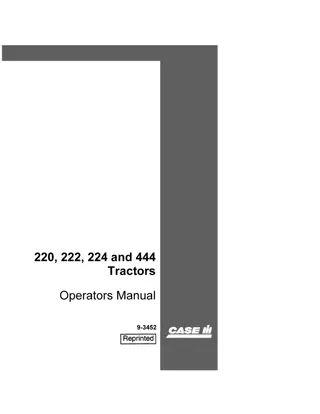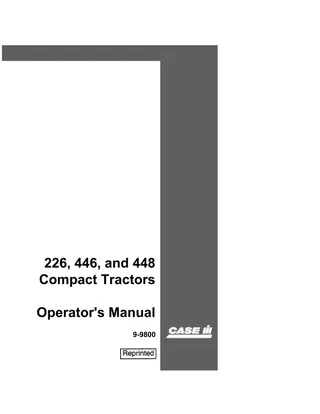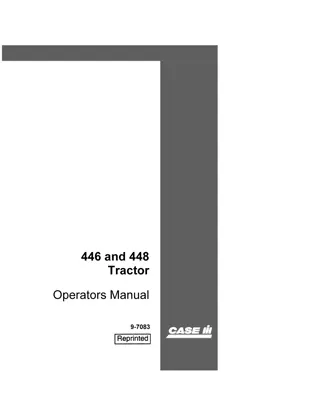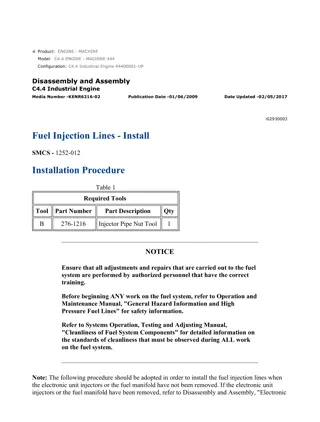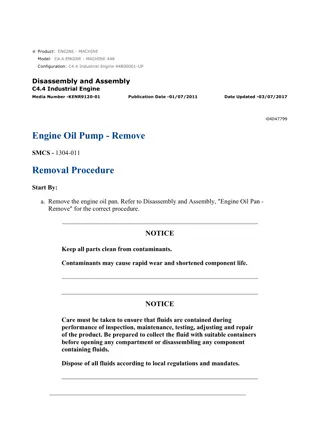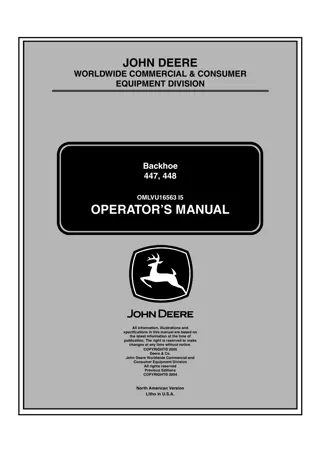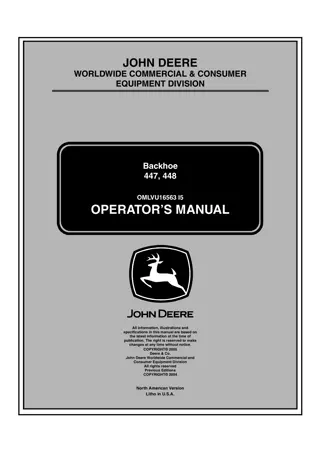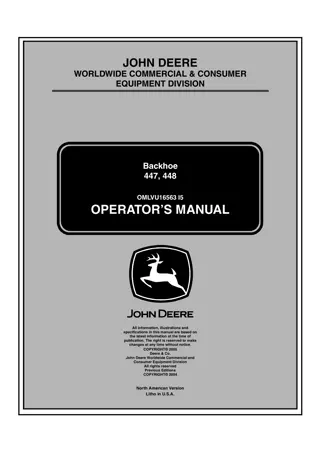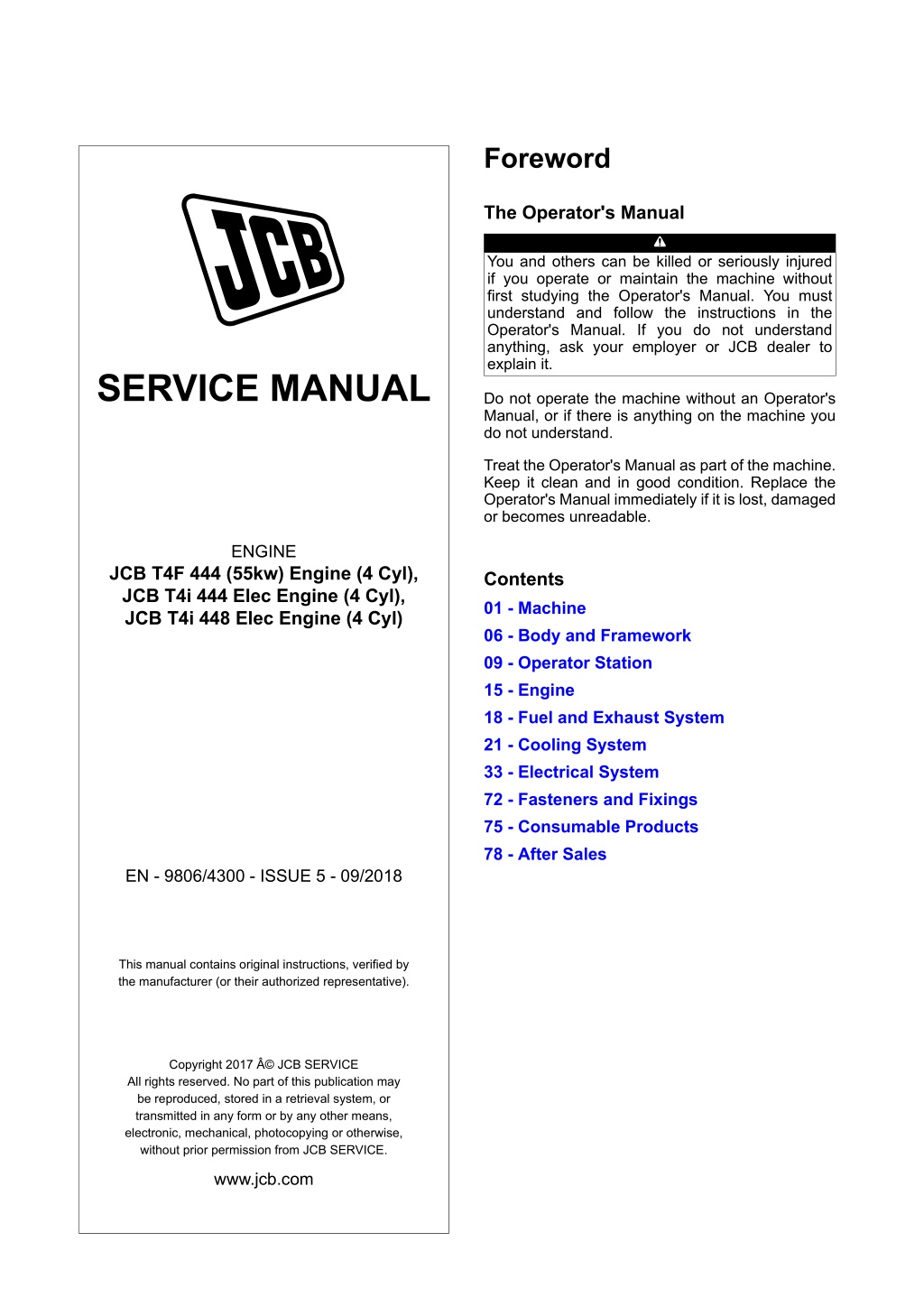
JCB T4F 444 (55KW) Engine (4 Cyl), T4i 444 Elec Engine (4 Cyl), T4i 448 Elec Engine (4 Cyl) Service Repair Manual Instant Download
Please open the website below to get the complete manualnn//
Download Presentation

Please find below an Image/Link to download the presentation.
The content on the website is provided AS IS for your information and personal use only. It may not be sold, licensed, or shared on other websites without obtaining consent from the author. Download presentation by click this link. If you encounter any issues during the download, it is possible that the publisher has removed the file from their server.
E N D
Presentation Transcript
Foreword The Operator's Manual You and others can be killed or seriously injured if you operate or maintain the machine without first studying the Operator's Manual. You must understand and follow the instructions in the Operator's Manual. If you do not understand anything, ask your employer or JCB dealer to explain it. SERVICE MANUAL Do not operate the machine without an Operator's Manual, or if there is anything on the machine you do not understand. Treat the Operator's Manual as part of the machine. Keep it clean and in good condition. Replace the Operator's Manual immediately if it is lost, damaged or becomes unreadable. ENGINE JCB T4F 444 (55kw) Engine (4 Cyl), JCB T4i 444 Elec Engine (4 Cyl), JCB T4i 448 Elec Engine (4 Cyl) Contents 01 - Machine 06 - Body and Framework 09 - Operator Station 15 - Engine 18 - Fuel and Exhaust System 21 - Cooling System 33 - Electrical System 72 - Fasteners and Fixings 75 - Consumable Products 78 - After Sales EN - 9806/4300 - ISSUE 5 - 09/2018 This manual contains original instructions, verified by the manufacturer (or their authorized representative). Copyright 2017 JCB SERVICE All rights reserved. No part of this publication may be reproduced, stored in a retrieval system, or transmitted in any form or by any other means, electronic, mechanical, photocopying or otherwise, without prior permission from JCB SERVICE. www.jcb.com
01 - Machine Contents Page No. 01-00 Introduction 01-00-00 General ............................................................................................................................. 01-3 01-00-04 Product Compliance ......................................................................................................... 01-4 01-00-06 Intended Use .................................................................................................................... 01-5 01-03 Safety 01-03-03 Safety - Yours and Others ............................................................................................... 01-7 01-03-06 Safety Warnings ............................................................................................................... 01-8 01-03-09 General Safety ................................................................................................................. 01-9 01-03-12 Maintenance Safety ....................................................................................................... 01-10 01-03-18 Operating Safety ............................................................................................................ 01-11 01-03-21 Worksite Safety .............................................................................................................. 01-12 01-03-24 Risk Assessment ............................................................................................................ 01-13 01-06 About this Manual 01-06-00 General ........................................................................................................................... 01-15 01-09 Description 01-09-00 General ........................................................................................................................... 01-17 01-12 Operation 01-12-00 General ........................................................................................................................... 01-19 9806/4300-5 2018-07-24
01 - Machine 00 - Introduction 00 - Introduction Contents Page No. 01-00-00 General ............................................................................................................................. 01-3 01-00-04 Product Compliance ......................................................................................................... 01-4 01-00-06 Intended Use .................................................................................................................... 01-5 01 - 1 9806/4300-5 01 - 1
https://www.ebooklibonline.com Hello dear friend! Thank you very much for reading. Enter the link into your browser. The full manual is available for immediate download. https://www.ebooklibonline.com
01 - Machine 00 - Introduction 00 - General 00 - General Introduction Before you start using the machine, you must know how the machine operates. Use this part of the manual to identify each control lever, switch, gauge, button and pedal. Do not guess, if there is anything you do not understand, ask your JCB dealer. 01 - 3 9806/4300-5 01 - 3
01 - Machine 00 - Introduction 04 - Product Compliance 04 - Product Compliance Introduction Your JCB product was designed to comply with the laws and regulations applicable at the time of its manufacture for the market in which it was first sold. In many markets, laws and regulations exist that require the owner to maintain the product at a level of compliance relevant to the product when first produced. Even in the absence of defined requirements for the product owner, JCB recommend that the product compliance be maintained to ensure safety of the operator and exposed persons and to ensure the correct environmental performance. Your product must not be altered in any way which could affect or invalidate any of these requirements. For advice consult your JCB dealer. For its compliance as a new product, your JCB and some of its components may bear approval numbers and marking's, and may have been supplied with a Declaration/Certificate of Conformity. These marking's and documents are relevant only for the country/region in which the product was first sold to the extent that the laws and regulations required them. Re-sales and import/export of products across territories with different laws and regulations can cause new requirements to become relevant for which the product was not originally designed or specified. In some cases, pre owned products irrespective of their age are considered new for the purposes of compliance and may be required to meet the latest requirements which could present an insurmountable barrier to their sale/use. Despite the presence of any compliance related marking's on the product and components, you should not assume that compliance in a new market will be possible. In many cases it is the person responsible for import of a pre owned product into a market that becomes responsible for compliance and who is also considered the manufacturer. JCB may be unable to support any product compliance related enquiry for a product which has been moved out of the legislative country/ region where it was first sold, and in particular where a product specification change or additional certification would have been required in order for the product to be in compliance. 01 - 4 9806/4300-5 01 - 4
01 - Machine 00 - Introduction 06 - Intended Use 06 - Intended Use Introduction This JCB engine can be fitted to a variety of construction and agricultural machines and equipment. The scope of this publication is limited to the engine, but references to typical applications may be made. When the JCB engine is used as power source for pumps, generators and independent power source for pumps, generators, independent power units etc, the operating controls and procedures must be provided by the original equipment manufacturer (OEM). Always refer to the original equipment (OEM) Operator Manual for safe operating instructions. 01 - 5 9806/4300-5 01 - 5
01 - Machine 03 - Safety 03 - Safety Contents Page No. 01-03-03 Safety - Yours and Others ............................................................................................... 01-7 01-03-06 Safety Warnings ............................................................................................................... 01-8 01-03-09 General Safety ................................................................................................................. 01-9 01-03-12 Maintenance Safety ....................................................................................................... 01-10 01-03-18 Operating Safety ............................................................................................................ 01-11 01-03-21 Worksite Safety .............................................................................................................. 01-12 01-03-24 Risk Assessment ............................................................................................................ 01-13 01 - 6 9806/4300-5 01 - 6
01 - Machine 03 - Safety 03 - Safety - Yours and Others 03 - Safety - Yours and Others Introduction All machinery can be hazardous. When a machine is correctly operated and maintained, it is a safe machine to work with. When it is carelessly operated or poorly maintained it can become a danger to you (the operator) and others. In this manual and on the machine you will find warning messages, you must read and understand them. They inform you of potential hazards and how to avoid them. If you do not fully understand the warning messages, ask your employer or JCB dealer to explain them. Safety is not just a matter of responding to the warnings. All the time you are working on or with the machine you must be thinking of what hazards there might be and how to avoid them. Do not work with the machine until you are sure that you can control it. Do not start any work until you are sure that you and those around you will be safe. If you are not sure of anything, about the machine or the work, ask someone who knows. Do not assume anything. Remember: Be careful Be alert Be safe. 01 - 7 9806/4300-5 01 - 7
01 - Machine 03 - Safety 06 - Safety Warnings 06 - Safety Warnings Introduction In this manual there are safety notices. Each notice starts with a signal word. The signal word meanings are given below. The signal word 'DANGER' indicates a hazardous situation which, if not avoided, will result in death or serious injury. The signal word 'WARNING' indicates a hazardous situation which, if not avoided, could result in death or serious injury. The signal word 'CAUTION' indicates a hazardous situation which, if not avoided, could result in minor or moderate injury. The signal word 'Notice' indicates a hazardous situation which, if not avoided, could result in machine damage. The safety alert system symbol (shown) also helps to identify important safety messages in this manual. When you see this symbol your safety is involved, carefully read the message that follows. Figure 1. The safety alert system symbol 01 - 8 9806/4300-5 01 - 8
01 - Machine 03 - Safety 09 - General Safety 09 - General Safety Lifting Equipment You can be injured if you use incorrect or faulty lifting equipment. You must identify the weight of the item to be lifted then choose lifting equipment that is strong enough and suitable for the job. Make sure that lifting equipment is in good condition and complies with all local regulations. Raised Equipment Never walk or work under raised equipment unless it is supported by a mechanical device. Equipment which is supported only by a hydraulic device can drop and injure you if the hydraulic system fails or if the control is operated (even with the engine stopped). Make sure that no-one goes near the machine while you install or remove the mechanical device. Raised Machine Never position yourself or any part of your body under a raised machine which is not correctly supported. If the machine moves unexpectedly you could become trapped and suffer serious injury or be killed. Lightning Lightning can kill you. Do not use the machine if there is lightning in your area. Machine Modifications This machine is manufactured in compliance with prevailing legislative requirements. It must not be altered in any way which could affect or invalidate its compliance. For advice consult your JCB dealer. Introduction Training To operate the machine safely you must know the machine and have the skill to use it. You must abide by all relevant laws, health and safety regulations that apply to the country you are operating in. The operator's manual instructs you on the machine, its controls and its safe operation; it is not a training manual. Ensure that you receive the correct training before operating any machinery. Failing to do so will result in incorrect operation of the machine and you will be putting yourself and others at risk. In some markets, and for work on certain jobsites, you may be required to have been trained and assessed in accordance with an operator competence scheme. Make sure that you and your machine comply with relevant local laws and jobsite requirements it is your responsibility. Care and Alertness All the time you are working with or on the machine, take care and stay alert. Always be careful. Always be alert for hazards. Clothing You can be injured if you do not wear the correct clothing. Loose clothing can get caught in the machinery. Keep cuffs fastened. Do not wear a necktie or scarf. Keep long hair restrained. Remove rings, watches and personal jewellery. Alcohol and Drugs It is extremely dangerous to operate machinery when under the influence of alcohol or drugs. Do not consume alcoholic drinks or take drugs before or while operating the machine or attachments. Be aware of medicines which can cause drowsiness. Feeling Unwell Do not attempt to operate the machine if you are feeling unwell. By doing so you could be a danger to yourself and those you work with. Mobile Phones Switch off your mobile phone before entering an area with a potentially explosive atmosphere. Sparks in such an area could cause an explosion or fire resulting in death or serious injury. Switch off and do not use your mobile phone when refuelling the machine. 01 - 9 9806/4300-5 01 - 9
01 - Machine 03 - Safety 12 - Maintenance Safety 12 - Maintenance Safety lubricants. Used fluids and/or lubricants, filters and contaminated materials must be disposed of in accordance with local regulations. Use authorised waste disposal sites. Introduction Hot Components Touching hot surfaces can burn skin. The engine and machine components will be hot after the unit has been running. Allow the engine and components to cool before servicing the unit. Turning the Engine Do not try to turn the engine by pulling the fan or fan belt. This could cause injury or premature component failure. Notice: The engine and other components could be damaged by high pressure washing systems. Special precautions must be taken if the machine is to be washed using a high pressure system. Make sure that the alternator, starter motor and any other electrical components are shielded and not directly cleaned by the high pressure cleaning system. Do not aim the water jet directly at bearings, oil seals or the engine air induction system. WARNING! To bleed the injectors you must turn the engine. When the engine is turning, there are parts rotating in the engine compartment. Before starting this job make sure that you have no loose clothing (cuffs, ties etc) which could get caught in rotating parts. When the engine is turning, keep clear of rotating parts. Notice: Clean the engine before you start engine maintenance. Obey the correct procedures. Contamination of the fuel system will cause damage and possible failure of the engine. Notice: Do not exceed the maximum level of engine oil in the sump. If the maximum is exceeded, the excess must be drained to the correct level. An excess of engine oil could cause the engine speed to increase rapidly without control. WARNING! The engine has exposed rotating parts. Switch off the engine before working in the engine compartment. Do not use the machine with the engine cover open. WARNING! Hot oil and engine components can burn you. Make sure the engine is cool before doing this job. Used engine crankcase lubricants contain harmful contaminants. In laboratory tests it was shown that used engine oils can cause skin cancer. Notice: A drive belt that is loose can cause damage to itself and/or other engine parts. WARNING! Do not open the high pressure fuel system with the engine running. Engine operation causes high fuel pressure. High pressure fuel spray can cause serious injury or death. CAUTION! It is illegal to pollute drains, sewers or the ground. Clean up all spilt fluids and/or 01 - 10 9806/4300-5 01 - 10
01 - Machine 03 - Safety 18 - Operating Safety 18 - Operating Safety Hot Components Touching hot surfaces can burn skin. The engine and machine components will be hot after the unit has been running. Allow the engine and components to cool before servicing the unit. Fires If your machine is equipped with a fire extinguisher, make sure it is checked regularly. Keep it in the correct machine location until you need to use it. Do not use water to put out a machine fire, you could spread an oil fire or get a shock from an electrical fire. Use carbon dioxide, dry chemical or foam extinguishers. Contact your nearest fire department as quickly as possible. Introduction Machine Condition A defective machine can injure you or others. Do not operate a machine which is defective or has missing parts. Make sure the maintenance procedures in this manual are completed before using the machine. Machine Limits Operating the machine beyond its design limits can damage the machine, it can also be dangerous. Do not operate the machine outside its limits. Do not try to upgrade the machine performance with unapproved modifications or additional equipment. Exhaust Gases Machine exhaust gases can harm and possibly kill you or bystanders if they are inhaled. Do not operate the machine in closed spaces without making sure there is good ventilation. If possible, install an exhaust extractor. If you begin to feel drowsy, stop the machine at once and get into fresh air. Communications Bad communications can cause accidents. Keep people around you informed of what you will be doing. If you will be working with other people, make sure any hand signals that may be used are understood by everybody. Worksites can be noisy, do not rely on spoken commands. Safety Barriers Unguarded machines in public places can be dangerous. In public places, or where your visibility is reduced, place barriers around the work area to keep people away. Sparks Explosions and fire can be caused by sparks from the exhaust or the electrical system. Do not use the machine in closed areas where there is flammable material, vapour or dust. Hazardous Atmospheres This machine is designed for use in normal out door atmospheric conditions. It must not be used in an enclosed area without adequate ventilation. Do not use the machine in a potentially explosive atmosphere, i.e. combustible vapours, gas or dust, without first consulting your JCB dealer. Regulations Obey all laws, worksite and local regulations which affect you and your machine. Machine Safety Stop work at once if a fault develops. Abnormal sounds and smells can be signs of trouble. Examine and repair before resuming work. 01 - 11 9806/4300-5 01 - 11
01 - Machine 03 - Safety 21 - Worksite Safety 21 - Worksite Safety An applicable worksite organisation is required in order to minimise hazards that are caused by restricted visibility. The worksite organisation is a collection of rules and procedures that coordinates the machines and people that work together in the same area. Examples of worksite organisation include: Introduction WARNING You or others can be killed or seriously injured if you do unfamiliar operations without first practising them. Practise away from the worksite on a clear area. Keep other people away. Do not perform new operations until you are sure you can do them safely. WARNING There could be dangerous materials such as asbestos, poisonous chemicals or other harmful substances buried on the site. If you uncover any containers or you see any signs of toxic waste, stop the machine and advise the site manager immediately. WARNING Before you start using the machine, check with your local gas company if there are any buried gas pipes on the site. If there are buried gas pipes we recommend that you ask the gas company for any specific advice regarding the way you must work on the site. Some modern gas pipes cannot be detected by metal detectors, so it is essential that an accurate map of buried gas pipes is obtained before any excavation work commences. Hand dig trial holes to obtain precise pipe locations. Any cast iron pipes found must be assumed to be gas pipes until contrary evidence is obtained. Older gas pipes can be damaged by heavy vehicles driving over the ground above them. Leaking gas is highly explosive. If a gas leak is suspected, contact the local gas company immediately and warn all personnel on the site. Ban smoking, make sure that all naked lights are extinguished and switch off any engines which may be running. You are strongly advised to make sure that the safety arrangements on site comply with the local laws and regulations concerning work near buried gas pipes. CAUTION Before you start using the machine, check with your local public water supplier if there are buried pipes and drains on the site. If there are, obtain a map of their locations and follow the advice given by the water supplier. You are strongly advised to make sure that the safety arrangements on site comply with the local laws and regulations concerning work near buried pipes and drains. CAUTION If you cut through a fibre optic cable, Do not look into the end of it, your eyes could be permanently damaged. Restricted areas Controlled patterns of machine movement A system of communication. You and/or your company could be legally liable for any damage you may cause to public utilities. It is your responsibility to make sure that you know the locations of any public utility cables or pipes on the worksite which could be damaged by your machine. 01 - 12 9806/4300-5 01 - 12
01 - Machine 03 - Safety 24 - Risk Assessment 24 - Risk Assessment Loading/Unloading Area Is it level? Any slope of more than 2.5% (1 in 40) must be carefully considered. Is more than one direction of approach to the load possible? Approaching across the slope must be avoided, if possible. Is the ground solid? Will it support the weight of the machine when loaded? How rough is the ground? Are there any sharp projections which could cause damage, particularly to the tyres? Are there any obstacles or hazards in the area, for example, debris, excavations, manhole covers, power lines? Is the space sufficient for safe manoeuvring? Are any other machines or persons likely to be in or to enter the area while operations are in progress? Introduction It is the responsibility of the competent people that plan the work and operate the machine to make a judgement about the safe use of the machine, they must take into account the specific application and conditions of use at the time. It is essential that a risk assessment of the work to be done is completed and that the operator obeys any safety precautions that the assessment identifies. If you are unsure of the suitability of the machine for a specific task, contact your JCB dealer who will be pleased to advise you. The following considerations are intended as suggestions of some of the factors to be taken into account when a risk assessment is made. Other factors may need to be considered. The Route to be Travelled How solid is the ground, will it provide sufficient traction and braking? Soft ground will affect the stability of the machine and this must be taken into account. How steep are any slopes, up/down/across? A cross slope is particularly hazardous, is it possible to detour to avoid them? A good risk assessment depends on the training and experience of the operator. Do not put your life or the lives of others at risk. Personnel Weather Are all persons who will take part in the operation sufficiently trained, experienced and competent? Are they fit and sufficiently rested? A sick or tired operator is a dangerous operator. Is supervision needed? Is the supervisor sufficiently trained and experienced? As well as the machine operator, are any assistants or lookouts needed? How windy is it? High wind will adversely affect the stability of a loaded machine, particularly if the load is bulky. Is it raining or is rain likely? The ground that was solid and smooth when dry will become uneven and slippery when wet, and it will not give the same conditions for traction, steering or braking. The Machine Is it in good working order? Have any reported defects been corrected? Have the daily checks been carried out? Are the tyres still at the correct pressure and in good condition and is there sufficient fuel to complete the job (if applicable)? The Load How heavy is it? Is it within the capabilities of the machine? How bulky is it? The greater the surface area, the more affected it will be by wind speeds. Is it an awkward shape? How is the weight distributed? Uneven loads are more difficult to handle. Is there a possibility of the load shifting while being moved? 01 - 13 9806/4300-5 01 - 13
01 - Machine 06 - About this Manual 06 - About this Manual Contents Page No. 01-06-00 General ........................................................................................................................... 01-15 01 - 14 9806/4300-5 01 - 14
01 - Machine 06 - About this Manual 00 - General 00 - General Introduction This publication is designed for the benefit of JCB Distributor Service Engineers who are receiving, or have received, training by JCB Technical Training Department. These personnel should have a sound knowledge of workshop practice, safety procedures, and general techniques associated with the maintenance and repair of engines. Renewal of oil seals, gaskets, etc., and any component showing obvious signs of wear or damage is expected as a matter of course. It is expected that components will be cleaned and lubricated where appropriate, and that any opened hose or pipe connections will be blanked to prevent excessive loss of hydraulic fluid, engine oil and ingress of dirt. Finally, please remember above all else SAFETY MUST COME FIRST! The manufacturer's policy is one of continuous improvement. The right to change the specification of the engine without notice is reserved. No responsibility will be accepted for discrepancies which may occur between the specifications of the engine and the descriptions contained in this publication. 01 - 15 9806/4300-5 01 - 15
01 - Machine 09 - Description 09 - Description Contents Page No. 01-09-00 General ........................................................................................................................... 01-17 01 - 16 9806/4300-5 01 - 16
01 - Machine 09 - Description 00 - General 00 - General Introduction The JCB Engine can be installed to a variety of construction, agricultural and other machines and equipment. The scope of this publication is limited to the engine, but references to a typical installation will be made. When the JCB Engine is used as a power source for pumps, generators, independent power units etc., the operating controls and procedures must be provided by the Original Equipment Manufacturer (OEM). Always refer to Original Equipment Manufacturer (OEM) Operator Manual for safe operating instructions. 01 - 17 9806/4300-5 01 - 17
01 - Machine 12 - Operation 12 - Operation Contents Page No. 01-12-00 General ........................................................................................................................... 01-19 01 - 18 9806/4300-5 01 - 18
01 - Machine 12 - Operation 00 - General 00 - General Introduction (For: JCB T4i Elec Engine (4 Cyl)) Notice: Do not keep the accelerator pedal fully depressed when the engine has started. Do not race the engine until the oil pressure low light has gone out. Racing the engine too soon could damage the turbo-charger due to insufficient lubrication. Several performance of the engine, these include: factors will influence the starting The ambient temperature The condition of the battery The viscosity of the engine oil The condition of the starter motor The engine does not require any cold starting aids for temperatures down to -12 C (10.4 F). If the engine is operating in temperatures below -12 C (10.4 F) then pre-heater is available. The heater is installed in the inlet manifold and is linked into the machine's electrical system. In severe cold climate conditions, a block heater can be installed. Make sure that all the necessary machine pre-start checks have been completed, these will include: Engine oil level Engine coolant level Battery connections Fuel tank has sufficient fuel Fuel pre-filters drained of water The machine is safe and ready to start 01 - 19 9806/4300-5 01 - 19
Suggest: If the above button click is invalid. Please download this document first, and then click the above link to download the complete manual. Thank you so much for reading
06 - Body and Framework Contents Page No. 06-63 Identification Label 06-63-06 Engine .............................................................................................................................. 06-3 9806/4300-5 2017-10-18
https://www.ebooklibonline.com Hello dear friend! Thank you very much for reading. Enter the link into your browser. The full manual is available for immediate download. https://www.ebooklibonline.com

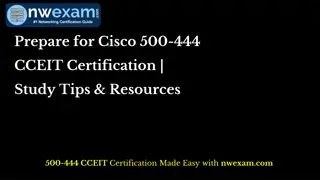
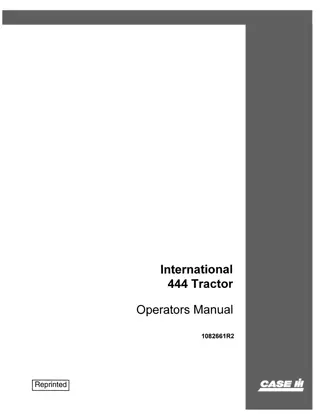
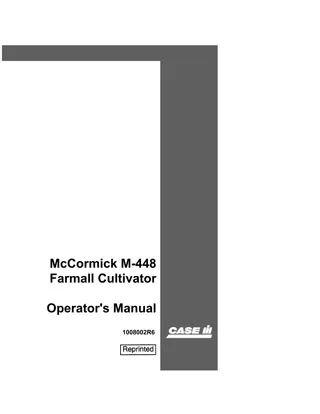
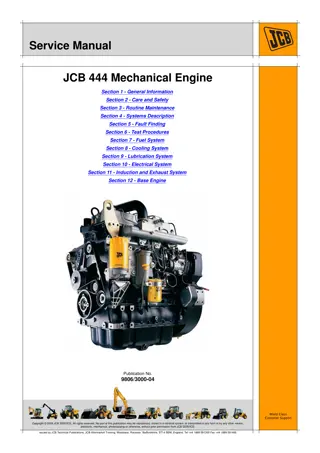
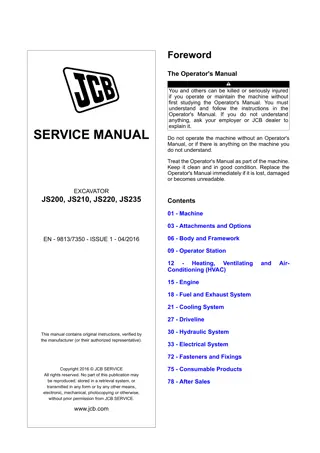
![JCB JZ140 [T4i], JZ141 [T4F] Excavator Service Repair Manual Instant Download](/thumb/98278/jcb-jz140-t4i-jz141-t4f-excavator-service-repair-manual-instant-download.jpg)
